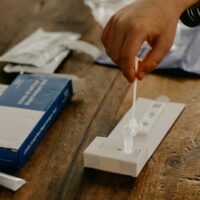As coronavirus cases continue to surge across the country, our most valuable resource in the fight against COVID-19 — the health care professionals needed to battle the virus — are being stretched to their limit.
Health care workers at Jennie Stuart have been battling the stress and fatigue that comes with treating COVID-19 patients for nearly eight months. Since March, nearly every front-line nurse has been working one to two extra days each week, on top of their typical three 12-hour shifts, said Beth McCraw, the hospital’s vice president of nursing and clinical services.
“That is so, so hard for them to continue,” McCraw said. “I think everybody is very willing to step up and do what we have to do during a crisis, but the problem that we’re seeing now more than ever is this crisis has no end.
“This is just an ongoing crisis, and as long as everybody is continuing to kind of practice as usual out in the community and not really follow the recommendations that have been provided by CDC, that’s just gonna continue to get worse.”
Public officials across the state have expressed frustration at a continued unwillingness to follow guidance aimed at curbing the virus’s spread. The noncompliance, coupled with the state’s record case numbers over the last several weeks, prompted Gov. Andy Beshear to issue an executive order Wednesday suspending all in-person instruction and eliminating indoor service for bars and restaurants.
In Christian County, where red zone reduction guidance has been in place for three weeks, numbers have continued to escalate at an alarming pace.
During the first six months of the pandemic, 1,167 residents tested positive for the virus. Then as community transmission quickened, it took less than two months to double that number — and since mid-September, 1,406 people have been infected. In the last week, the county has averaged 38 new cases per day — up from an average of 24 new cases per day last week.
Local hospitalizations have also seen a sharp increase, growing by more than 150% over the last two weeks. The number of patients being treated at Jennie Stuart reached a record high on Wednesday of 27.
It’s a trend that concerns public officials and health care workers, who are already exhausted and stretched thin.
‘A huge amount of resources’
It’s not just the volume of coronavirus patients that has stretched hospital staff thin. In part, it’s the increased level of care each of them requires.
“These COVID patients — regardless of whether or not they’re in the ICU or in our progressive care unit, which is a step-down unit, or up on a medical surgical floor — they require a huge amount of resources,” McCraw said. “And when I mean resources, I’m not talking about just PPE, I’m talking about our most valuable resource, which is our staff.”
Each COVID-19 patient is in isolation and unable to have visitors, so they are completely reliant upon nurses and clinical caregivers. That alone increases the time personnel must devote to care, but it’s compounded when you consider additional challenges that accompany even the simplest tasks, like bringing a patient a cup of water or some medication.
Before anyone can enter the room of a COVID-19 patient, they have to scrub up as normal. Then, they must don an isolation gown, gloves, an N95 mask and a face shield. If the nurse or clinician needs something once they’re inside the room, they try to request it from a “runner” so they don’t have to repeat the process all over again, McCraw said.
“So what we’re seeing is a lot of times, especially in our intensive care units, is these nurses are going in there and they’re spending an hour at a time, and they’re by themselves a lot of times,” McCraw explained.
Often, they’re doing tasks that can be challenging for just one person, like moving a sedated patient on a ventilator or bathing someone with a chest tube, which requires a significant amount of precision and care. It also takes an emotional toll.
“When they got home, they’re exhausted, they sleep for hours and hours and hours, and they just … they don’t get any down time,” McCraw said. “My heart aches for all of them, because it’s not fair that we haven’t got to a point in our community that people understand that.”
Non-coronavirus patients are sicker and those who have ‘recovered’ are returning
The hospital is also seeing non-coronavirus patients who are sicker than normal, McCraw said.
She attributes it to people postponing primary care and other routine medical visits because of the outbreak.
Many who previously tested positive for COVID-19, but are no longer considered to have an active form of the virus, are also returning to the hospital. Their ailments range from shortness of breath, lingering pneumonia, pulmonary embolisms, and decreased lung capacity, she said.
“These are all real things that we’re seeing from these patients, so it’s not like you come in, you get treated, you get discharged, you go home and nothing ever happens again,” McCraw said. “People have ongoing problems related to COVID.”
It’s still not clear why some people have ongoing issues following a COVID-19 illness and others don’t.
“I can’t say it’s because this person had five different comorbidities that put them at a higher risk for it, if there’s just not a lot of rhyme or reason why some people will continue to have these lingering complications and the severity and the timeliness of when they come back are so varied, too,” she said.
The pandemic exacerbated a looming nursing shortage
Even before the coronavirus outbreak, hospitals across the country were experiencing nursing shortages.
As long-time nurses who had deferred their retirement finally left the industry and others opted to change careers in response to the pandemic, the deficit was exacerbated, McCraw said.
“We’re seeing people who have just decided this is too hard, this is not what I signed up for,” she continued. “And they’re quitting, they’re changing careers altogether, and these nursing schools can’t pump out nurses quick enough because a nursing program is gonna be several years long.”
Additionally, recent nursing graduates — many of whom didn’t participate in traditional clinicals because of the pandemic — are requiring more training and longer orientation periods.
Jennie Stuart has also had to deal with staffing issues prompted by employees testing positive for the virus or being required to quarantine, which further impacts the hospital’s ability to provide care, even when the individual isn’t a clinical staff member.
“What if we had our Environmental Services out? They’re the ones that help us turn over these rooms,” McCraw said. “They’re the ones that do the cleaning and they keep everything sterile when it needs to be sterilized, and there are all these things that they do that are so important.”
Hospital capacity contingent on limited staffing
For McCraw, Jennie Stuart’s capacity isn’t simply a number of empty beds. It’s a combination of three ever-changing factors: real estate, staffing and acuity, or the severity of patient illnesses.
“Real estate is not our problem,” she said. “I’ve got to have staff to cover all of it.”
Because patients have been sicker lately, many are treated in the hospital’s progressive care unit, a step below the ICU, which is where the most critically ill patients are hooked up to ventilators or are receiving intravenous medication to stabilize their blood pressure.
In the ICU, the hospital aims to have one nurse on staff for every two patients. In the PCU, it’s typically a four-to-one ratio. Depending on the severity of patients’ illnesses, this could change to one-to-one in the ICU or three-to-one in the PCU, McCraw said. On occasion, an ICU nurse might have three patients, but McCraw noted, “that’s not what we want,” because it’s such a heavy burden on nurses.
Due to staffing limitations, the hospital can only admit about eight to 12 patients to the ICU and PCU at any given time. If demands increase in one area over the other, adjustments can be made, but the overall capacity between the two would likely be somewhere around 20.
If the hospital has reached its maximum capacity based on staffing and other factors, patients are diverted to another hospital in the region.
Hospitals’ backup options have become limited
Because COVID-19 cases are surging in every corner of the state, transferring patients to cooperating hospitals when resources are strapped has become more of a challenge.
“What we’re starting to find now is having the capability of transferring people out — whether it’s COVID or non-COVID — is becoming increasingly more difficult because hospitals are stretched,” McCraw said. “They are at what they would consider a capacity level.
“Getting a patient transferred to another area for high-level care regardless of their diagnosis is a challenge, and it’s gonna continue to be a challenge.”
COVID-19 hospitalizations in Kentucky have tripled between Sept. 16 and Nov. 16. On Wednesday, 1,553 Kentuckians were being treated for the virus.
Across the border in Tennessee, staffing shortages are also limiting capacity.
Dr. Steven Stack, Kentucky’s public health commissioner, has warned that the exponential growth of COVID-19 cases is threatening to overwhelm the health care system.
Health care workers at the fire and health departments also stretched thin
In an effort to help shed light on the burden being felt by all medical workers, the Hopkinsville Fire Department began posting its total number of ambulance service calls, including those with COVID-19 patients.
“The month of October 2020 was the busiest run volume month in the history of the Hopkinsville Fire Department,” said Fire Chief Steve Futrell in a Facebook post Monday. “Since COVID tracking began on March 6, 2020, the Hopkinsville Fire Department has encountered 415 COVID positive or suspected patients. It is important to note that as surprising as these numbers are, they are also on the rise.”
Of those 415 patients, 37 were transported last week.
The Christian County Health Department is feeling a similar strain, as it struggles to keep up with the growing number of direct contacts and works to identify clusters, while providing guidance and resources to those individuals who have tested positive. The department also operates a COVID-19 testing site.
“Currently, the health department has 351 active cases, which means we are responsible for contacting 351 positive case individuals as well as their contacts,” health department spokeswoman Amanda Sweeney said in a news release Wednesday. “If each positive case has 10 direct contacts, we are essentially working with 3,510 people at one time.
“The state has temporarily provided contact tracers to help with the caseloads, but the gravity in numbers even supersedes the contact tracing team, and additional health department staff has been pulled to help manage the case load.”
Much like the hospital and fire department, the health department also is responsible for a long list of critical public health services that aren’t related to COVID-19, including providing vaccinations, supporting new and expectant parents, administering federal nutrition assistance and conducting a variety of mandatory health inspections.
McCraw hopes the community will take notice of the strain being placed on not just the hospital, but other local health agencies like the fire and health departments, and take steps to stop the spread of COVID-19 and make sure those who need care will be able to get it.
“Every decision that people make out there — whether they wear their mask or don’t wear their mask, or whether they go to a gathering or don’t go to a gathering — directly impacts the people that care for them here in this community.”
Julia Hunter is the engagement editor for Hoptown Chronicle. Reach her at julia@hoptownchronicle.org.





